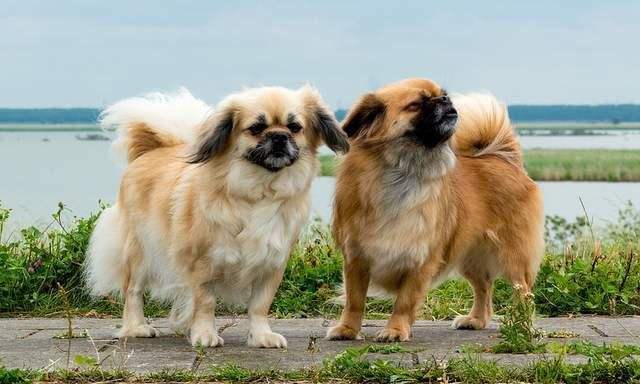Tibetan Spaniel
IUCN
LCBasic Information
Scientific classification
- name:Tibetan Spaniel
- Scientific Name:palace dog, sleeve dog
- Outline:Carnivora
- Family:Canidae
Vital signs
- length:25cm
- Weight:7kg
- lifetime:13-14年
Feature
They are intelligent, cheerful, lively, active, and always in a good mood. They are highly alert to any sound, love their owner's family and are full of affection, but are very cold to visiting strangers.
Distribution and Habitat
Native to Tibet
Appearance
The Tibetan Spaniel has a small head, in proportion to the body, and carried proudly. The quality of this dog is very good. The male is impressively strong, not coarse or mean. The dark brown eyes are oval, bright and expressive, of moderate size, well spaced, and face straight ahead, like an ape. The eye rims are black. Light, large, full eyes, and a mean expression are to be penalized. The ears are of moderate size and drooping, with a lot of feathering on the ears in adults, and set high. The ears appear to be slightly above the head, but not flying. The skull is well domed, of equal length and width. A skull that is too broad, too domed, or too flat is to be penalized.
The slight stop is well defined. The muzzle is blunt and soft, of moderate length and free of wrinkles. The chin is deep and slightly broad. A too strong stop; a face that is too long or flattened; a broad, flat muzzle; a pointed, weak, or wrinkled muzzle are to be penalized. Black nose is preferred. Faults: A liv
Details
Tibetan Hound is commonly called "Sleeve Dog". It is native to Tibet in the Himalayas. It is one of the ancient dog breeds in China and also a fine dog breed with a mysterious color.

The Tibetan Hound originated in ancient Tibet, China. It was once used as a monk or companion, but is now only used as a companion dog. It is generally believed that it has appeared since the 7th century AD. It was raised by Tibetan lamas. Although it is called a hunting dog, the Tibetan Hound has never participated in hunting. Legend has it that this kind of dog is used for prayer. It is highly intelligent and is trained to help monks turn the prayer barrel. It is also a companion dog for monks and helps monks guard their homes. It always follows the monks' prayer carts covered with parchment. For centuries, they have been companion dogs in temples and are also used as ornamental dogs. It is said that Tibetan Buddhist monks sent Buddhist scriptures and Spaniels into the rotating Buddhist instruments a long time ago, so they are called prayer dogs. The smallest Tibetan Spaniel weighs less than 1 kilogram. It is widely rumored that many great living Buddhas in Tibetan Buddhist temples and upper-class Tibetan nobles kept them with them in the past. Later, it was introduced from Tibet to the mainland and raised in the Qing Dynasty palace, so it is also called a court dog. The Tibetan Spaniel is not very well-known in the world, but this dog has been naturally bred. Now, excellent purebreds are very rare. In recent years, their value has doubled. Some overseas dog lovers have offered tens of thousands of dollars to buy them. This ancient dog breed in Tibet is closely related to the Pekingese, and has similar appearance and coat color to the Pekingese.
A breed very similar to the Tibetan Hound existed in present-day South Korea in the 8th century AD. However, it is not clear whether it was introduced from Tibet, China.
The changes in the eyes of the Tibetan Hound are the changes in its mood. When angry, the pupils open, the eyes hang up, and it shows a scary look; when sad and lonely, the eyes are moist, and it feels like it is talking. When happy, the eyes are bright, full of confidence or hope; when trusted, it will never look away. On the contrary, if it is oppressed by others or has something outstanding, it will shift its gaze and lower its head and roll its eyes; when it is sick or depressed, its eyes are lazy and weak; when it does not trust people, its eyes flicker. If the Tibetan Hound is baring its teeth and claws, it is a precursor to attack. Generally, it wrinkles its nose, vibrates its upper lip, and exposes its upper teeth. This is to inform the other party that it is going to attack, with a strong threat purpose.
There is no formal Tibetan Spaniel Association in China, and it has not received proper attention and protection. It can be said that it is left to its own devices. If this situation continues, Tibetan Spaniels will be in danger of extinction in China. Therefore, I hope that friends who like Tibetan Spaniels can do something to protect Tibetan Spaniels and let them survive in China for a long time.
Protect wild animals and eliminate game.
Maintaining ecological balance is everyone's responsibility!








